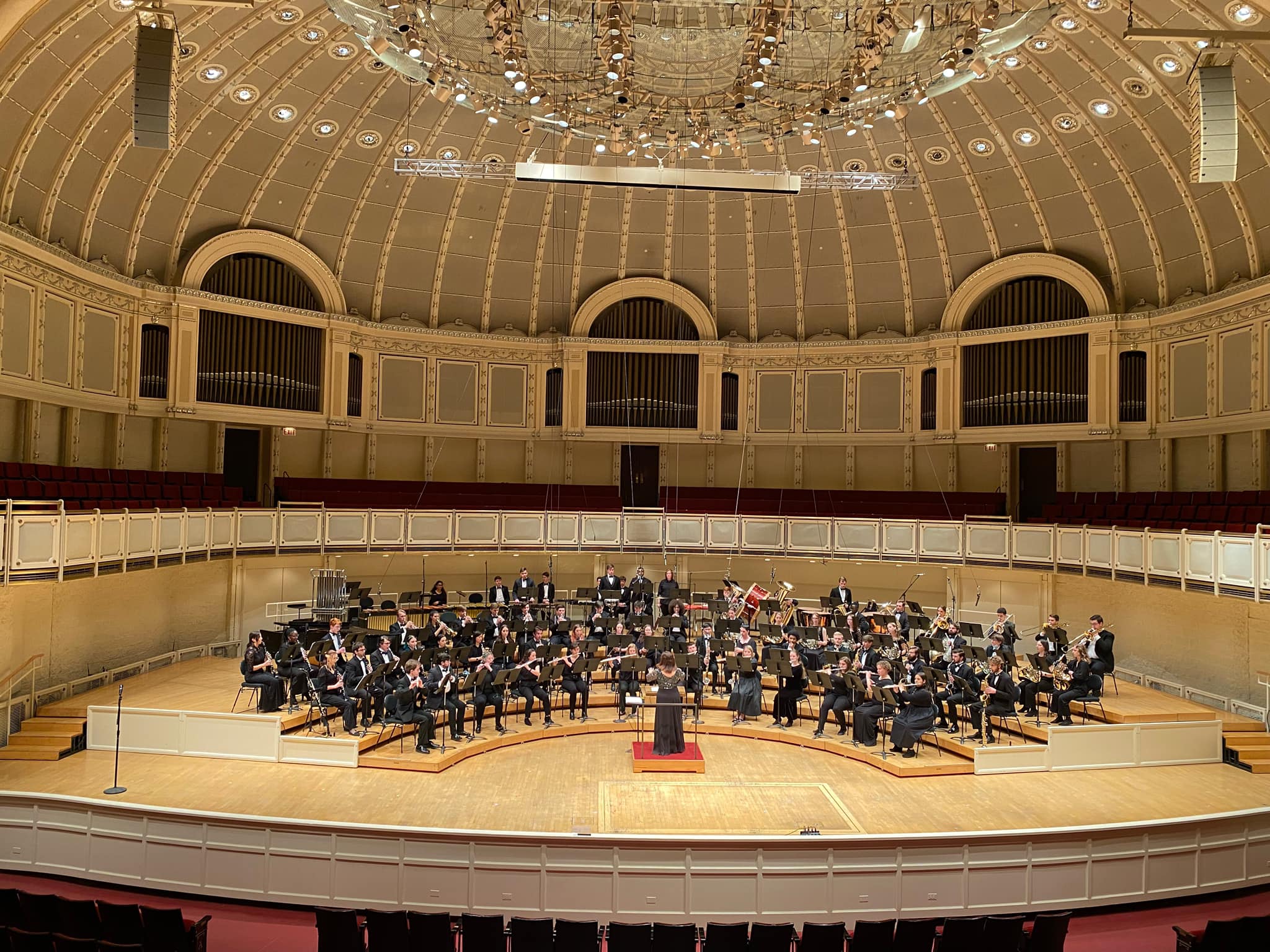
Furman University Symphonic Band
Spring Concert
April 7, 2022 | 7:30 p.m.
McAlister Auditorium
Dr. Sue Samuels, conductor
The Belle of Chicago - John Philip Sousa
Lincolnshire Posy - Percy Grainger
- Lisbon
- Horkstow Grange
- Rufford Park Poachers
- Brisk Young Sailor
- Lord Melbourne
- Lost Lady Found
Fin De Siècle - Blake Buehler, world premiere
Blake Buehler, student conductor
Icarus - Willie Cornish, Jr.
Part One: Inside the Labyrinth, world premiere
Nick Wilson, student conductor
"March" from Symphonic Metamorphosis - Paul Hindemith
The Belle of Chicago by John Philip Sousa
Sousa completed the band full score of The Belle of Chicago on July 23, 1892, in Washington, D.C. This date was precisely one week before his discharge from the Marine Corps to form his own civilian band, which, incidentally, was based in Chicago, so it is not at all surprising Sousa sought to curry favor with this Midwestern metropolis. Some have speculated the title was intended for Ada Blakely, wife of his new manager, David Blakely.
Chicago would prove an important performance site for Sousa for many years, and reviews from the Chicago press were always important. An unidentified press clipping from the Sousa Band press books demonstrates that initial reaction to The Belle of Chicago was not everything Sousa might have hoped. What he intended as a salute to the ladies of Chicago received this stinging criticism from one writer: “Mr. Sousa evidently regards the Chicago belle as a powerful creature, with the swinging stride of a giant, a voice like a fog-horn, and feet like sugar-cured hams”. And "Mr. Sousa has made his Chicago belle a strapping kitchen wench..."
This one negative review, while humorous, did not overshadow the fact this was one of Sousa’s best marches to date. The arresting four-bar introduction and the lean four-strain format (without breakup strain/dogfight/episode) is vigorous and exciting, with an irresistible momentum.
- Program note by Senzoku Gakuen College of Music Blue Tie Wind Ensemble concert program, 21 December 2012
Lincolnshire Posy by Percy Grainger
Percy Aldridge Grainger (1882-1961) was born in Australia. He studied music from a young age with his mother. He enjoyed early success as a concert pianist on several continents. At the outbreak of WWI he enlisted as an army bandsman (oboist). He became a U.S. citizen in 1919 and made many worldwide concert tours. As a composer he was a remarkable innovator, using irregular rhythms and pioneering in field music collection. In 1905-1906 he traveled throughout Lincolnshire, England using a gramophone to record local yeomen singing their songs. He was the first to attempt to transcribe these songs with musical notation. He tried to retain the original flavor of these local singers by strict observance of peculiarities of performances such as varying beat lengths.
Lincolnshire Posy was commissioned by the American Bandmasters Association and premiered at their convention with the composer conducting. It is in six movements, all based on folk songs from Lincolnshire, England. Grainger's settings are not only true to the verse structure of the folk songs, but attempt to depict the singers from whom Grainger collected the songs. Since its premiere, it has been recognized as a cornerstone of the wind band repertoire.
“Lincolnshire Posy, as a whole work, was conceived and scored by me direct for wind band early in 1937. Five, out of the six, movements of which it is made up existed in no other finished form, though most of these movements (as is the case with almost all my compositions and settings, for whatever medium) were indebted, more or less, to unfinished sketches for a variety of mediums covering many years (in this case, the sketches date from 1905 to 1937). These indebtednesses are stated in the score.
This bunch of "musical wildflowers" (hence the title) is based on folksongs collected in Lincolnshire, England (one notated by Miss Lucy E. Broadwood; the other five noted by me, mainly in the years 1905-1906, and with the help of the phonograph), and the work is dedicated to the old folksingers who sang so sweetly to me. Indeed, each number is intended to be a kind of musical portrait of the singer who sang its underlying melody -- a musical portrait of the singer's personality no less than of his habits of song -- his regular or irregular wonts of rhythm, his preference for gaunt or ornately arabesqued delivery, his contrasts of legato and staccato, his tendency towards breadth or delicacy of tone.”
- Program Note by Percy Aldridge Grainger
Fin De Siècle by Blake Buehler, world premiere
Fin De Siècle is the end of an era. A radical departure from old traditions, the initiation of new aesthetics and artistry. This work reflects my journey through my early composition career. The elements of the composition are symbolic of various key points in my Furman education, and the themes are a tribute to the people who have been my close friends and mentors over the past four years. Fin De Siècle is my final farewell to this chapter of my life, and my first celebration of what is to come.
Icarus by Willie Cornish, Jr.
Icarus is a two-movement wind ensemble piece retelling the Greek Mythology story of Icarus. Icarus's father Daedalus, a very talented Athenian craftsman, built the Labyrinth for King Minos of Crete near his palace at Knossos to imprison the Minotaur, a half-man, half-bull monster born of his wife and the Cretan bull. Minos imprisoned Daedalus himself in the labyrinth because he gave Minos's daughter, Ariadne, a clew (or ball of string) in order to help Theseus, the enemy of Minos, to survive the Labyrinth and defeat the Minotaur.
Icarus and Daedalus attempt to escape from the Crete labyrinth by means of wings that Daedalus constructed from feathers and wax. Daedalus fashioned two pairs of wings out of wax and feathers for himself and his son. Daedalus tried his wings first. But before trying to escape the island, he warned his son not to fly too close to the sun, nor too close to the sea, but to follow his path of flight. Icarus ignores Daedalus’s instructions not to fly too close to the sun, causing the wax in his wings to melt. He tumbles out of the sky, falls into the sea, and drowns.
The first movement depicts Icarus and Daedalus trapped in the labyrinth. As the piece progresses, you can hear the two venturing through the labyrinth, Daedalus creating the wings, and finally the two escaping Crete. The second movement depicts their triumphant flight and eventual tragic fall of Icarus.
Symphonic Metamorphosis by Paul Hindemith
Paul Hindemith (1895-1963) was a German composer who started his career in his native country but immigrated to the United States in 1940 due to disagreements with the Nazi regime. While in America, he taught at Yale University and eventually became an American citizen in 1946. Hindemith can easily be classified as a “modern” composer due to his desire to push the boundaries of tonality in many of his compositions. He created a system that blurred the lines between consonance and dissonance.
Hindemith’s "March" from Symphonic Metamorphosis is the fourth movement of the work, which is based on a set of piano duets by Carl Maria von Weber. The main theme of the composition is taken from a funeral march and can be heard throughout the first half of the piece. Later, a triumphant horn melody set in two measure phrases is presented and alternates with the initial theme. Hindemith first composed Symphonic Metamorphosis in 1943, and in 1960, he asked one of his colleagues at Yale, Keith Wilson, to arrange the March for concert band. After 18 months of work, Wilson completed the arrangement, and today, Symphonic Metamorphosis is regarded as one of Hindemith’s most popular compositions.
